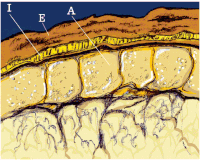
Photo from wikipedia
Abstract Laboratory experiments were conducted in Pakistan to investigate the effectiveness of the diatomaceous earth (DE) formulation, Protect-It, at 150 ppm and imidacloprid, at 1.25, 2.5 and 5.0 ppm, alone or in… Click to show full abstract
Abstract Laboratory experiments were conducted in Pakistan to investigate the effectiveness of the diatomaceous earth (DE) formulation, Protect-It, at 150 ppm and imidacloprid, at 1.25, 2.5 and 5.0 ppm, alone or in combination, against the rusty grain beetle, Cryptolestes ferrugineus Stephens (Coleoptera: Laemophloeidae), the lesser grain borer, Rhyzopertha dominica (F.) (Coleoptera: Bostrychidae), the red flour beetle, Tribolium castaneum (Herbst) (Coleoptera: Tenebrionidae) and the psocid, Liposcelis paeta Pearman (Psocoptera: Liposcelididae). The bioassays were conducted at 25 °C, 65% relative humidity (r.h.) and continuous darkness by using adults of each insect pest that were exposed on treated or untreated wheat, rice and maize. Adult mortality counts were performed 1, 2, 4 and 7 days post-exposure. Progeny production was also evaluated 62 and 30 days after the last mortality count for beetles and psocid respectively. Results showed that mortality was increased with the increase of dose and exposure interval. Imidacloprid was more effective at the highest dose than the DE alone. The combination of DE plus imidacloprid resulted to higher mortalities than DE or imidacloprid alone at almost all exposure intervals. There was higher mortality on wheat than on rice or maize. In general, T. castaneum was the most tolerant insect species to any treatment while L. paeta was the least tolerant. The highest progeny production was observed for T. castaneum (i.e., 33.1 individuals per vial) while the lowest for L. paeta (i.e., 11.1 individuals per vial) on maize treated with Protect-It alone. The findings of the current study indicate that the combined use of DE and imidacloprid, as wheat, rice and maize protectants, may provide adequate level of management to several important stored-product insects.
Journal Title: Journal of Stored Products Research
Year Published: 2021
Link to full text (if available)
Share on Social Media: Sign Up to like & get
recommendations!